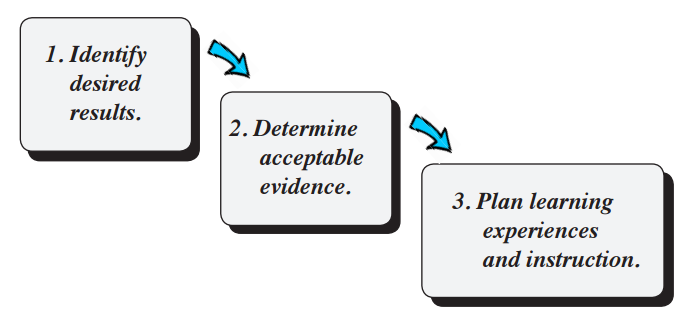Everything should be made as simple as possible, but not simpler. – Albert Einstein
I have always admired the simplicity and elegance of the formula E=mc2 of Einstein., but one has to admit that despite appearing very simple, there is a lot of thinking behind it. Likewise, this week’s assignment, Creating a Significant Learning Plan, at first, after reading three chapter of the book “Understanding by Design,” it’s seems very simple, and maybe it is, but not for me because not everything that glitters is gold, or maybe I tend to complicate things unnecessarily. Even though in a certain way, I am kind of familiarize with the Backward Design Lesson Plan because I use the 5 Step I do, We do, You do Lesson Plan, It had never been easy for me to plan a lesson.
The UbD or Backward Design Lesson Plan is the method I used to create my Significant Learning Plan. I am using the last week’s 3 Column Table project as a base to create this unit lesson. The Backward Design consists of three stages.

- The main focus in Stage 1 is making sure that our learning goals are stated regarding significant accomplishments reflective of understanding. The goal of understanding has two implications: 1) making meaning of big ideas, and 2) independent transfer of learning to new situations.
- The focus in Stage 2 is valid evidence – assuring that what we assess and how we evaluate follows logically from the Stage 1 goals. Evaluating for understanding requires proof of the student’s capacity to insightfully describe or interpret their learning – to show their work and to support their output with an explanation.
- The focus in Stage 3 is making sure that what we teach and how we teach develops logically from and aligns with the Stage 1 and Stage 2 goals. The learning experiences are designed to address three interrelated goals: Acquisition, Meaning Making, and Transfer (McTighe & Wiggins, 1999).
Another tool of UbD that is very useful in lesson planning is the WHERETO elements of UbD. WHERETO is an acronym for planning steps to help meet the requirements of the unit. Also, WHERETO does not represent the order to be followed.
I agree with Dr. Harapnuik (2015) when he states that “[one] should never be satisfied with a singular approach or perspective to developing effective learning environments.” I think that by combining these three methods of lesson planning, it will make this task much easier. Now, I can see that I planned my lessons from a very limited perspective. I used to plan lesson by lesson. I did not see the whole picture. I used to plan with the wrong kind of “backward design.” Now, I’m going to use the 3 Column Table method to plan my projects and big units, the UbD method for units, and the 5 Step I do, We do, You do method for individual lessons.
References
Harapnuik, D. (2015, Aug 15) EDLD 5313 Module 4 – Creating your learning plan (Video file). Retrieve from LAMAR University website: https://luonline.blackboard.com/webapps/blackboard/content/listContent.jsp?course_id=_111118_1&content_id=_2564114_1
McTighe, J. & Wiggins, G. (1999). The understanding by design Handbook. Alexandria, VA. Association for Supervision and Curriculum Development.
